 Typical PCs Each Year
Typical PCs Each Year
In 1997, Microsoft became the world's most valuable company with a value of $261 BN, Scotland and Wales devolved from England and the first cloned mammal, Dolly the Sheep, was announced in Edinburgh - it survived 6 years.
Tiger Woods became the youngest person to win the Masters, Steve Jobs went back to Apple, and the comet Hale-Bopp got the closest to Earth, being visible in the night sky for 18 months.
In film, we got Men in Black, Air Force One, Liar Liar, and The Full Monty.
But we're here to talk computers...
CPUs and Motherboards
In 1997 AMD launched their new K6 microprocessor, along with the Super 7 standard to extend the life of the Socket 7 motherboard, competing against Intel who moved to "Slot 1" with their new Pentium II. Super 7 effectively was a combination of Socket 7 + AGP + 100 MHz FSB. The main chipsets that competed in the war to dominate the latest motherboard offerings came from four camps: Intel, with their 430TX chipset, VIA with the VP3 (and later MVP3), SiS with the 5591, and ALi with the Aladdin V. The 430TX from Intel was definitely ahead of the pack, though Intel deliberately stunted it to push up sales of the Pentium II. The VP2 was much faster than Intel's 430HX and usually supported Cyrix/IBM CPUs' Linear Burst Mode, and the VP3 was the first from VIA to provide AGP support.
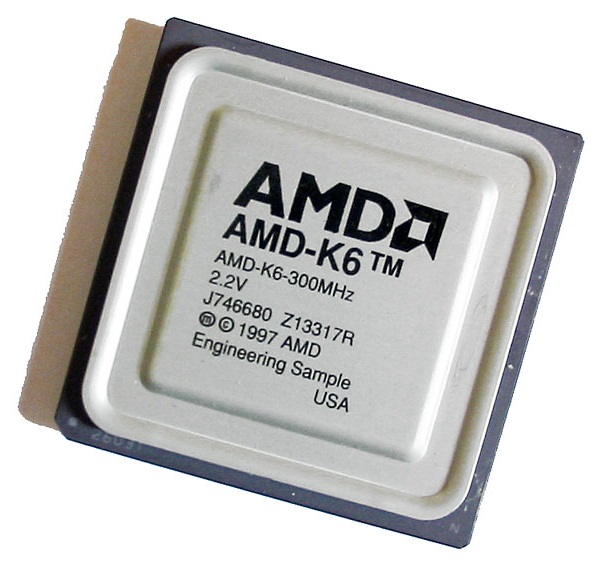
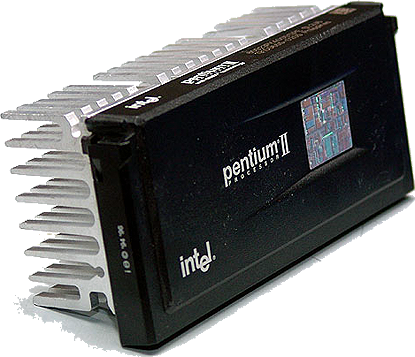
AMD K6 Microprocessor vs Intel Pentium II
Intel's new Pentium II (which as mentioned came on a card that fitted into a new slot) took the P6 core from the short-lived Pentium Pro and made some improvements. The card meant the CPU was closely coupled with an "off-die" L2 cache. Clock speeds rose to new heights this year, with the PII being available up to 300 MHz, still all running on a 66 MHz front side bus.
Here are some typical costs of CPUs mid-way through the year: AMD K5-100: $64, K5-133: $77, K5-166: $105, K6-166: $244, K6-200: $294. Pentium 100: $100, Pentium 133: $140, Pentium 200: $260. Pentium MMX 166: $259, Pentium MMX 200: $320.
An Intel "Triton III" 430VX motherboard with PCI local bus was $85. For the 430TX version it was $100.
Memory
Most PCs sold in 1997 came with anywhere from 8MB up to 32MB of RAM. These could be 30-pin or 72-pin SIMMs which cost around $10 per megabyte, or even the newer 168-pin DIMM modules which were more like $7 per megabyte (you had to pay more for older technology!).
Fixed Storage
Hard disk capacities in 1997 ranged from 1.2 GB up to 7 GB, with the cheapest starting at around $150 USD for a 1.2 GB IDE drive, up to $430 USD for a 7 GB IDE. SCSI pushed the starter price tag up to $240 USD, but at the upper end of the scale you could buy a SCSI hard disk with 23 GB of space for $2,200. That put the price per megabyte as low as $8. A lot of hard disk manufacturers were still competing in 1997, including companies we still see today such as Seagate, Fujitsu and Western Digital, but also JTS, Maxtor, Quantum, Connor and Micropolis.
Desktops
The price gap between laptops and desktops had been falling consistently year on year, as technology improved to drop the price of laptop components. At the low end of the desktop market was the Pentium 133 MHz (non-MMX), 16 MB RAM (EDO), 1.2 GB IDE hard disk drive, and PCI graphics card. Or something like this Pentium 233 MMX from Gateway 2000 - for just $1,000 more (again, without monitor) you got one of these with 32 MB RAM and a 3.2 GB hard disk.
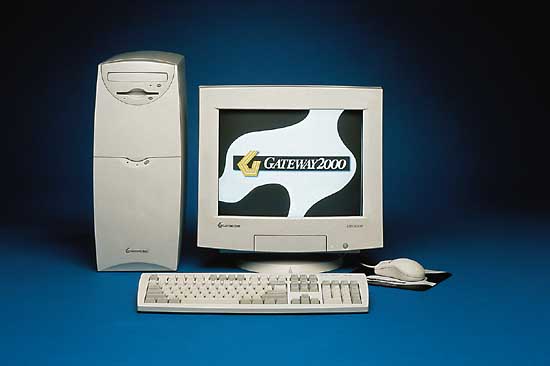 />
/>
A Gateway tower computer from 1997
Laptops
In 1997, Compaq, Toshiba and IBM were the kings of the portable world, though competition was fierce with smaller players like Acer, AST, Fujitsu, Texas Instruments and Hewlett-Packard also having some of the market. Base models usually came with a Pentium 120 MHz, 16 MB of RAM and a 1 GB hard disk. The screen on these was a fairly horrible DSTN (dual-scan) but at least they were all colour at this point. A machine like this would cost around $1,700 to $1,800. Moving up to a Pentium 133 would add $200 to the cost, and if you wanted the MMX version it would be $700 more!
Most laptops apart from the sub-notebooks came with an 8-speed or 10-speed CD-ROM drive. To get an active matrix TFT display was a huge price jump of $1,000 to $1,500 more, so for a top-of-the-line notebook like the Toshiba Tecra 740CDT with Pentium MMX 166 MHz, 16 MB RAM, 3 GB hard disk, 10x CD-ROM drive, 13.3" active matrix TFT and integrated fax/voice modem, the price tag was a whopping $5,800.
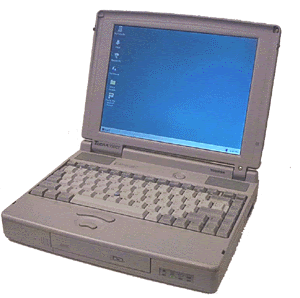
Toshiba Tecra 730CDT (1997)
Removable Media
Iomega were still pushing the ZIP and JAZ drives in 1997. Removable media for the JAZ went up to 1 GB per disk, making it a viable alternative to buying a larger hard disk! The cheaper ZIP drive, whose disks could store 100 MB each could be bought for $150. The disks were about $15 each. The JAZ drive sold for around $350 and the disks were $85 each. All Iomega's drives were available in external parallel port versions as well as internal IDE (ATAPI), SCSI and USB.

Iomega ZIP (1994) and JAZ (1995) disks
By mid-1997, CD-ROM drive speeds had reached 24x territory, and CD Recorders were readily available (though for a premium price). A CD-ROM drive cost $80 for 12x, or $110 for 24x. To have CD-R recording capability the costs went from $300 and up. You could even be one of the first consumers to own DVD-R technology. Creative Labs were quick to the market with their "PC-DVD" package that included a DVD-ROM drive and interface card for $500.
It's also worth mentioning that the short-lived PD drives were available this year too, with Compaq and IBM desktops coming with PD drives
Graphics Cards
nVidia launched their 3Dfx Voodoo rival to main target in the 3D performance gaming segment, which was the Riva 128 which came with 4 MB RAM, a whopping 100 MHz core clock speed (twice that of the Voodoo), a 206 MHz RAMDAC and was compatible with AGP 2x. Furthermore, it was a combined 2D and 3D card, as they saw that not all gamers were emptying their pockets for a dedicated 3D card.

nVidia Riva 128 AGP 2x video card (1997)
Sadly, image quality was poor compared to the Voodoo as some games companies were embracing 3dfx's proprietary GLide API. The Riva 128 and rivals like the 3D Rage II instead supported the more popular DirectX 5 which arrived in August of this year.
Meanwhile, 3Dfx realised what nVidia did, that dedicated 3D card adoption was only for the wealthy, and so released the Voodoo Rush which added a 2D chip. Whilst the plan was a good one, the execution was not great, with estimates of the Rush's 3D performance at around 20% of the Voodoo, a direct result of sharing bandwidth between 2D and 3D chip, and the 2D performance in isolation was also poor. The card, to this day, is known as a poor performer, and best avoided.
ATI launched their second variant of the 3D Rage II (the 3D Rage II+DVD) which slightly improved both GPU and memory performance on the on the first 3D Rage II. They fought back against the RiVA 128 later on this year with the launch of the 4 MB Rage Pro alongside their now budget-oriented Rage IIc AGP - these were officially the first ever AGP 2x (133 MHz) cards. The Rage Pro had a 500 MB/s peak bandwidth (twice the throughput of AGP 1x cards). It supported resolutions up to 1600 x 1200, got improved DVD playback, and featured an integrated floating-point setup engine that could process up to 1.2 million triangles per second.
.png)
ATI 3D Rage Pro AGP 2x video card (1997)
S3 launched the ViRGE/DX this year as a low-end variant of the ViRGE/GX from last year. This would be the sign that S3 weren't keeping pace with the competition.
Rendition weren't doing well financially, so was sold to Micron, who, during the design of the upcoming Verite 3300, terminated the project on grounds of delays and other setbacks, and hence dropped out of the 3D card market.
Matrox were still in the running with their Millennium II, a 4 MB card with slightly lower throughput than the ATi Rage Pro. A Millennium II cost $190 in 1997.
DirectX 5.0 came out in this year, which was much enhanced over the previous version, DirectX 3.0 (DirectX 4.0 was never released). Up until this point, Direct3D was pretty poor with very limited capabilities.
Among other things, it added MMX optimisations, DrawPrimitive services for Direct3D (passing polygon info directly to the graphics card), DirectDraw now supported the AGP bus, and DirectInput now supported force feedback devices. In addition, DirectSound3D supported 3D audio hardware acceleration.
Monitors
Monitor sizes started at 14" diagonal and moved up to 21" at the top end for desktop computers. Prices started at around $200 for a 14", $290 for 15", $470 for 17", $870 for 19", $1050 for 20" and $1300 for 21". Viewsonic were often a slightly cheaper alternative to Samsung, Sony or Panasonic. In the U.S., Princeton were the budget brand of choice.
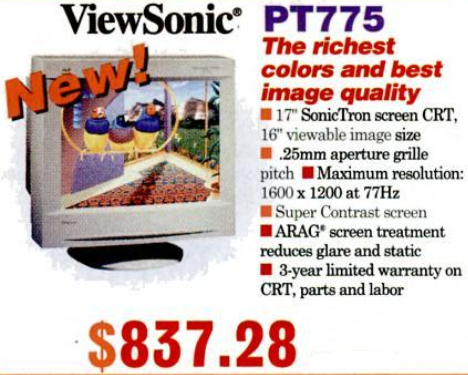
ViewSonic PT775 multi-scan 17" monitor (1997)
A Sony Multiscan 200SF with 0.25mm dot pitch cost $790 (the lower the dot pitch the sharper the image). The larger Sony Multiscan 20sell 20" monitor cost almost $1,800.
Sound Cards
Creative Labs was still the dominant force in sound card market (from a product range and revenue perspective). An AWE64 Gold would set you back $200, but the Value edition of the AWE64 was half this. Sound Blaster 16 Basic, you only needed $70.
Printers and Scanners
On the inkjet/bubblejet market, Epson, HP and Canon were the big players (as they are today) - Epson Stylus 400 (a 4ppm 720dpi printer) was $200. The Stylus 600 (6ppm and 1440 dpi) sets you back a further $100. Competing with these was HP's Deskjet, the 692C.
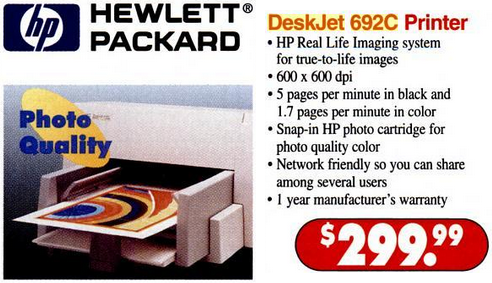
HP Deskjet 692C Inkjet printer (1997)
Meanwhile Canon with their bubble jet technology (slightly different but similar principle tech) offered a cheaper alternative to Epson, with the BJC-240 (4ppm, 720dpi) for $170. An HP Laserjet 6Lse, capable of 600x600 dpi and at speeds of up to 6 ppm in black and white cost $400.
Software
Of course by 1997 (actually several years before then), DOS software was still being sold but had dropped to a fraction of the market compared to Windows software. Numerous businesses were still actively running necessary DOS applications inside a Windows command shell. But most consumers were on Windows 95 and would typically have the full Office suite, with Microsoft Office 97 Standard Edition costing around $200, though Corel's WordPerfect Suite 7 was still trying desperately to win over consumers despite the price tag being similar ($240), as was Lotus with their SmartSuite 97. Seperate Office apps such as Excel 97 were $300, Outlook was $100, Access was $300, and Word was $300, so it just made sense to buy Office and be done with it. You could see what Microsoft were doing - pushing out numerous competitors by offering a cost-effective bundle. You were on their Operating System, and using their applications. Of course, 'Upgrade' versions of all Microsoft's product were available, which verified you had an earlier version before installing the latest one - these were often 1/3rd or 1/4 of the price of the full retail, non-upgrade version. For example, Windows 95 full retail cost $185, but an upgrade version was only £97.
Adobe PageMaker v6.5 would set you back $550, as would Photoshop v4.0.